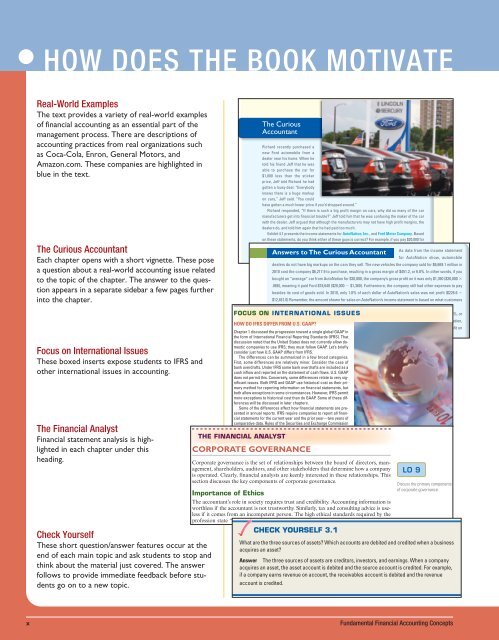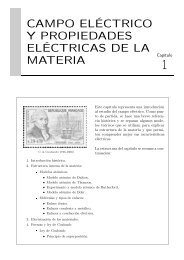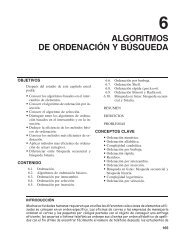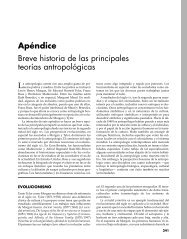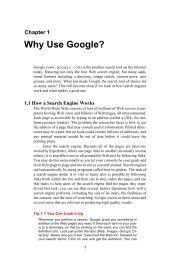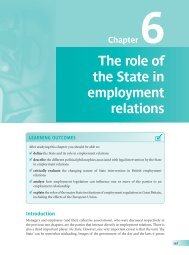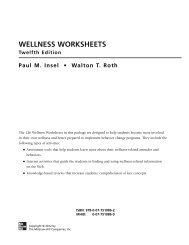Fundamental Financial Accounting Concepts - Novella - McGraw-Hill
Fundamental Financial Accounting Concepts - Novella - McGraw-Hill
Fundamental Financial Accounting Concepts - Novella - McGraw-Hill
You also want an ePaper? Increase the reach of your titles
YUMPU automatically turns print PDFs into web optimized ePapers that Google loves.
HOW DOES THE BOOK MOTIVATE<br />
Real-World Examples<br />
The text provides a variety of real-world examples<br />
of financial accounting as an essential part of the<br />
management process. There are descriptions of<br />
accounting practices from real organizations such<br />
as Coca-Cola, Enron, General Motors, and<br />
Amazon.com. These companies are highlighted in<br />
blue in the text.<br />
The Curious Accountant<br />
Each chapter opens with a short vignette. These pose<br />
a question about a real-world accounting issue related<br />
to the topic of the chapter. The answer to the question<br />
appears in a separate sidebar a few pages further<br />
into the chapter.<br />
Focus on International Issues<br />
These boxed inserts expose students to IFRS and<br />
other international issues in accounting.<br />
The <strong>Financial</strong> Analyst<br />
<strong>Financial</strong> statement analysis is highlighted<br />
in each chapter under this<br />
heading.<br />
Check Yourself<br />
These short question/answer features occur at the<br />
end of each main topic and ask students to stop and<br />
think about the material just covered. The answer<br />
follows to provide immediate feedback before students<br />
go on to a new topic.<br />
edm25362_ch04_206-267.indd Page 207 8/30/11 1:59 PM user-f494 /205/MHBR259/fra11404_disk1of1/0073511404/fra11404_pagefiles<br />
edm25362_ch04_206-267.indd Page 230 8/28/11 11:02 AM user-f501 /207/MHBR245/edm25362_disk1of1/0078025362/edm25362_page<br />
The Curious<br />
Accountant<br />
Richard recently purchased a<br />
new Ford automobile from a<br />
dealer near his home. When he<br />
told his friend Jeff that he was<br />
able to purchase the car for<br />
$1,000 less than the sticker<br />
price, Jeff told Richard he had<br />
gotten a lousy deal. “Everybody<br />
knows there is a huge markup<br />
on cars,” Jeff said. “You could<br />
have gotten a much lower price if you’d shopped around.”<br />
Richard responded, “If there is such a big profit margin on cars, why did so many of the car<br />
manufacturers get into financial trouble?” Jeff told him that he was confusing the maker of the car<br />
with the dealer. Jeff argued that although the manufacturers may not have high profit margins, the<br />
dealers do, and told him again that he had paid too much.<br />
Exhibit 4.1 presents the income statements for AutoNation, Inc., and Ford Motor Company. Based<br />
on these statements, do you think either of these guys is correct? For example, if you pay $20,000 for<br />
a vehicle from a dealership operated by AutoNation, the largest auto retailer in the United States,<br />
how much did the car cost the company? Also, how much did the car cost the Ford Motor As data Company from the income statement<br />
Answers to The Curious Accountant<br />
to manufacture? (Answers on page •••.)<br />
for AutoNation show, automobile<br />
dealers do not have big markups on the cars they sell. The new vehicles the company sold for $6,669.1 million in<br />
edm25362_ch03_138-205.indd Page 159 2010 cost 8/28/11 the company 10:07 AM $6,217.9 user-f501 to purchase, resulting in a /207/MHBR245/edm25362_disk1of1/0078025362/edm25362_pagefiles<br />
gross margin of $451.2, or 6.8%. In other words, if you<br />
bought an “average” car from AutoNation for $20,000, the company’s gross profit on it was only $1,360 ($20,000 3<br />
.068), meaning it paid Ford $18,640 ($20,000 2 $1,360). Furthermore, the company still had other expenses to pay<br />
besides its cost of goods sold. In 2010, only 1.8% of each dollar of AutoNation’s sales was net profit ($226.6 4<br />
$12,461.0) Remember, the amount shown for sales on AutoNation’s income statement is based on what customers<br />
actually paid for the cars the company sold, not the “sticker price.”<br />
FOCUS ON INTERNATIONAL Meanwhile, if Ford sold the car to ISSUES<br />
AutoNation for $18,640, it earned a gross margin on the sale of 12.4%, or<br />
$2,311 [$14,829 4 $119,280 5 12.4%; ($119,280 2 $104,451 5 $14,829)] [$18,640 3 .124 5 $2.311]. Like AutoNation,<br />
HOW DO IFRS DIFFER FROM U.S. GAAP?<br />
Ford still had other expenses to pay for besides the cost of goods sold. In 2010, Ford earned 5.1% of net profit on<br />
Chapter 1 discussed the progression toward a single global GAAP in<br />
the form of International<br />
each<br />
<strong>Financial</strong><br />
dollar of<br />
Reporting<br />
sales ($6,561<br />
Standards<br />
4 $128,954).<br />
(IFRS). That<br />
discussion noted that the United States does not currently allow domestic<br />
companies to use IFRS; they must follow GAAP. Let’s briefly<br />
consider just how U.S. GAAP differs from IFRS.<br />
The differences can be summarized in a few broad categories.<br />
First, some differences are relatively minor. Consider the case of<br />
bank overdrafts. Under IFRS some bank overdrafts are included as a<br />
cash inflow and reported on the statement of cash flows. U.S. GAAP<br />
does not permit this. Conversely, some differences relate to very significant<br />
issues. Both IFRS and GAAP use historical cost as their pri-<br />
edm25362_ch02_062-137.indd Page mary 85 method 8/19/11 for reporting 9:07 information AM user-f494 on financial statements, but /Volume/202/MHBR249/hiL29244_disk1of1/0078029244/hiL29244_pagefiles<br />
both allow exceptions in some circumstances. However, IFRS permit<br />
more exceptions to historical cost than do GAAP. Some of these differences<br />
will be discussed in later chapters.<br />
Some of the differences affect how financial statements are presented<br />
in annual reports. IFRS require companies to report all financial<br />
statements for the current year and the prior year—two years of<br />
comparative data. Rules of the Securities and Exchange Commission<br />
THE FINANCIAL ANALYST<br />
CORPORATE GOVERNANCE<br />
Corporate governance is the set of relationships between the board of directors, management,<br />
shareholders, auditors, and other stakeholders that determine how a company LO 9<br />
is operated. edm25362_ch03_138-205.indd Clearly, financial analysts Page are 143 keenly 8/19/11 interested 9:08 in these AM user-f494 relationships. This /Volume/202/MHBR249/hiL29244_disk1<br />
section discusses the key components of corporate governance.<br />
Discuss the primary components<br />
of corporate governance.<br />
Importance of Ethics<br />
The accountant’s role in society requires trust and credibility. <strong>Accounting</strong> information is<br />
worthless if the accountant is not trustworthy. Similarly, tax and consulting advice is useless<br />
if it comes from an incompetent person. The high ethical standards required by the<br />
profession state “a certified public accountant assumes an obligation of self-discipline<br />
b d b d i f l d l i ” h<br />
CHECK YOURSELF 3.1<br />
What are the three sources of assets? Which accounts are debited and credited when a business<br />
acquires an asset?<br />
Answer The three sources of assets are creditors, investors, and earnings. When a company<br />
acquires an asset, the asset account is debited and the source account is credited. For example,<br />
if a company earns revenue on account, the receivables account is debited and the revenue<br />
account is credited.<br />
x <strong>Fundamental</strong> <strong>Financial</strong> <strong>Accounting</strong> <strong>Concepts</strong>


